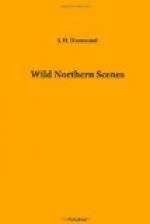by an atmosphere absolutely fatal to animal life; an
atmosphere which, while it stimulated vegetable growth,
no living thing could breathe and continue to live.
Hence it was, that vegetation, gigantic almost beyond
conception, covered its surface. Fern, which
is now a pigmy plant, nowhere higher than a few feet,
grew tall and overshadowing like great oaks, while
oaks, it is fair to presume, towered thousands of
feet towards the sky. These stupendous forests
stood alone upon the surface of the earth; no animals
wandered through their fastnesses; no birds sported
amidst their mighty branches; noxious exhalations
came steaming up from their tangled recesses, and
their gloomy shadows lay a mantle of darkness over
dreary and lifeless solitudes. The storms raged,
and the winds howled; the sun travelled its daily
rounds, with its light dimmed and clouded by the pestilential
vapors it exhaled, and silence, so far as the sounds
of animal life were concerned, reigned supreme—the
stillness of the grave, the quiet of utter desolation,
save the voice of the wind or the storm, was unbroken
all over the face of the earth. Onward, and onward,
rolled this mighty orb on its pathway through the
heavens, bearing with it no animal existences, freighted
with no human hopes—carrying with it nothing
of human destiny. Man, with all his lofty aspirations,
his mighty schemes, his glory, and his pride, was a
thing of the future. He had not yet emerged from
the eternity of the past, to grapple with the present,
or encounter the retributions of the eternity which
is to come. This was the era of gigantic vegetable
growth, and it had its uses; for it was preparing the
way for higher and more complicated existences.
As the gases that surrounded the earth became consolidated
into vegetation, as this stupendous growth decomposed
the noxious atmosphere, drawing from it its grosser
particles and working them up into solid matter, extracting
from it what was fatal to animal life, this earth
entered upon another era of its progress.
“Animal life made its appearance. It was
weak and feeble at first, but a step removed from
vegetable matter. The molusca, the polypi, and
the rudest forms of fishes, were, beyond question,
the first of living things. Science demonstrates
that the water brought forth the first creations endowed
with animal vitality. How long this era continued
no man can tell. Then came the amphibise, gigantic
animals of the lizard kind; the sauruses, that could
reach with their long necks and ponderous jaws across
a street and pick up a man, if street and man there
had been. Then came land animals, monstrous in
growth, by the side of which the elephant dwindles
to the diminutive stature of the dormouse. In
all these advances, was a succession of steps, mounting
higher and higher, in complication of structure, each
more perfect in organism than its predecessor.
Vegetation itself became more complicated, and as
it approached perfection lost its gigantic growth.




